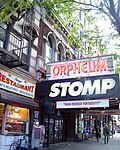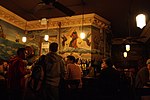Gem Spa

Gem Spa was a newspaper stand and candy store located on the corner of St. Mark's Place and Second Avenue in the East Village neighborhood of Manhattan, New York City. It opened under another name in the 1920s, and was renamed in 1957. It was open 24 hours a day, and was known for being commonly considered to be the birthplace of the authentic New York City-style egg cream, which its awning described as "New York's Best."Often referred to as a bodega, in the 1950s, Gem Spa was a gathering place for beats, and in the 1960s it was a hippie hangout, known for selling a wide selection of underground newspapers. New York Magazine named it the best newsstand in the East Village in 2001.On May 7, 2020, owner Parul Patel announced that the physical store would not re-open due to the impact of the COVID-19 pandemic and rent increases, despite community efforts and a social media campaign to keep it open.The building in which Gem Spa was located, 131 Second Avenue, or 36 St. Marks Place, was built in 1898-1900 and was designed by Louis F. Heinecke in the Renaissance Revival style. It is located within the East Village/Lower East Side Historic District, which was created in October 2012.
Excerpt from the Wikipedia article Gem Spa (License: CC BY-SA 3.0, Authors, Images).Gem Spa
Saint Marks Place, New York Manhattan
Geographical coordinates (GPS) Address Nearby Places Show on map
Geographical coordinates (GPS)
| Latitude | Longitude |
|---|---|
| N 40.728611111111 ° | E -73.987916666667 ° |
Address
Saint Marks Place & 2nd Avenue
Saint Marks Place
10003 New York, Manhattan
New York, United States
Open on Google Maps







